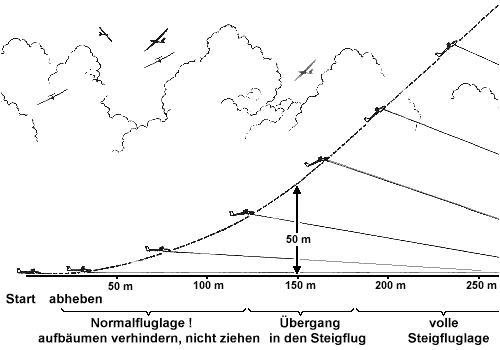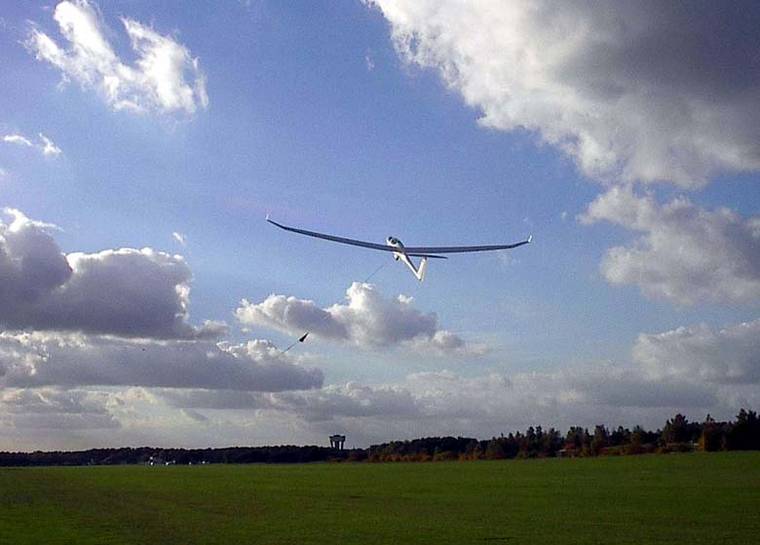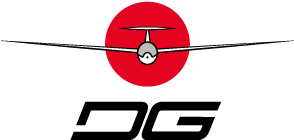The members of my club, The Bielefeld Gliding Association, have found the following article.
Winch launching is usually cheap and launches can be made rapidly, one after another. Because of this, it is the preferred launch method in most clubs especially for instructional flights.
 The tow cable is attached to a C.G. hook which, in older gliders like the ASK-13, is usually installed a little left of center. At the start of the launch full left rudder is used to counteract the slight pull to the right. But then you have to be careful not to roll over the cable, especially with a jerky start. It may be necessary to use a judicious amount of braking or have ground crew hold back the glider.
The tow cable is attached to a C.G. hook which, in older gliders like the ASK-13, is usually installed a little left of center. At the start of the launch full left rudder is used to counteract the slight pull to the right. But then you have to be careful not to roll over the cable, especially with a jerky start. It may be necessary to use a judicious amount of braking or have ground crew hold back the glider.
After reaching the minimum flying speed, the glider lifts off. Up till now the elevator is at a neutral position. Pulling back too earlier is not advisable and actually is dangerous since it would cause an early nose-high moment which actually already is there because the C.G. hook is well underneath the C.G. of the glider.
The climb begins rather flat and then with increasing altitude (about 150 ft) changes in a smooth curve to the full climbing attitude. The horizon disappears from view. The rest of the climb continues with a constant climb angle and constant speed. As a rule, nothing untoward happens. Even so, the climb must be constantly controlled by looking right and lift and making the necessary corrections especially in cross-winds.
In the last phase of a winch launch the climb angle gradually decreases and the horizon reappears. The back pressure on the stick is gradually released until a constant speed in normal flying attitude is reached. One waits until the cable back releases by itself or it can be released by the pilot. Then a normal pattern is begun. Pulling back on the stick to achieve the last foot of height just before release leads to a very sudden release and a high wing-loading. During this down wind part of the pattern and just after release, the release knob should be pulled three more times before trimming back and turning cross wind.
Possible disturbances, risks, and accident causes during the launch are:
- Tail dolly – Gliders without a tail wheel ( Ka-8 for instance) usually use a tail dolly to make them more maneuverable on the ground. Usually the glider is pushed into the starting position with the tail dolly on. Its absolutely necessary to remove this dolly before the launch. If not, the glider has a greater tendency to turn out at the start. Besides this, the C.G. is moved back possibly to a dangerous extent increasing the possibility of stalling and spinning. Because of this, Tail dolly off! should be part of the starting procedure.
- Weak link – Every tow cable is equipped with a so-called weak link. This link breaks at a specified value and prevents overloading the glider. Since the load limit on every glider is different, every glider should have its own weak link. If the wrong link is used which is weaker than specified, then it will likely break in full climb unnecessarily. A stronger than specified link may result in overloading the glider. Therefore, before connecting the cable, it is necessary to check for the proper link for the glider about to be launched.
- Rolling over the cable at the beginning of the launch – It can happen with a jerky start (especially older winches) that the glider rolls over the cable. In such a case, the pilot should release immediately otherwise the next tightening of the cable could result in damage to the glider or the cable becoming entangled with the wheel or wheel flaps.
- Turning out – Especially older gliders with the left sided tow hook have a higher tendency to turn out to the right at the beginning of the launch. A strong initial cable force can cause turning out to the right in spite of holding full left rudder. In such a case, immediate release is called for.
- Obstacles on the runway – Now and then, just when the glider gets hooked up, an obstacle will appear on the runway (People, towing vehicles, etc.). The starter or the winch driver will then stop the operation. Since the pilot cannot be sure if others have noticed it, he should pull the release to make sure the launch does not begin. The call: Runway clear! should be part of the starting procedure.
- Wing dropping to the ground – A wing touching the ground during the beginning of a launch can have catastrophic results. In the worst case, rotation about the long axis leaving the glider on its back could happen. The cause of such a thing lies mostly in an uneven pull by the winch plus a failure by the pilot to react properly. Since a wing drop is almost impossible to recover from, immediate release is the only thing to do. A two second wait can be too late.
- Cable break or winch failure – Even with good care and inspection of the cable, it must always be assumed that the cable will break. By the same token, a well-maintained winch can fail. A cable break or a winch failure should never be a problem for the pilot because it should be well covered in training. Especially dangerous is an interruption of the launch when immediately after the start, a full climb is initiated (A so-called cavalier-start which generally has catastrophic results). There are various recovery methods depending on the nature and length of the airport, the altitude at the cable break, and the wind.
- Cable break close to the ground: Release any back pressure and continue in normal flight, release the cable and land straight ahead.
- Cable breaks up to 300 ft: Release and land straight ahead using breaks and/or slipping as needed. Depending on runway conditions, flying and landing straight ahead is best as long as no other runway crosses the flight and roll-out path.
- With enough altitude and suitable wind and ground conditions, it is possible to make a 180 and land down wind. If the cable break occurs over 300 ft, an abbreviated pattern can be accomplished. The turn to final must be made with enough altitude to prevent the wing from touching. If this happens, the results can be catastrophic. The fundamental rule is to not force a spot landing and under no circumstances attempt to roll out back at the starting point. A safe landing in a neighboring field is, in every case, better than breaking the glider in an attempt to touch down at the standard landing point.
- Too high or too low a tow speed – Every aircraft has minimum flying speed which should not be approached during a winch launch. Otherwise there is the danger of stalling close to the ground which may well have fatal results. The glider also has a maximum allowed speed during a winch launch which must not be exceeded because of the danger of overloading the aircraft. The basic rule is that the speed must be held with the elevator between the two allowable limits. If that is not possible an immediate release is necessary after which fly as if it were a cable break.
- Stalling during a winch launch – This can have two causes. Firstly, allowing the speed to become too low (Vide supra). Secondly, uncontrolled, exaggerated, or jerky handling of the stick. This can cause a too high angle of attack followed by a stall. This may result in a steep dive or a spin. Therefore, there should be no exaggerated or jerky stick handling during the launch.
- Failure of the release mechanism – This is possible due to a technical defect or inadequate maintenance. The correct procedure is to remain in normal flight, make repeated attempts to release while waiting for automatic back release. If the glider flies over and beyond the winch, the winch driver will chop the cable. Continue to attempt to release the cable over an empty field if possible because a cable dragging on the ground can snag on something or injure someone.
- Collision with another aircraft – It can happen that other gliders will fly over the starting runway crossing your path. The danger here is that you might be launched into the path of another glider. In such a case, release immediately and avoid the other aircraft. Never assume the other guy sees you. The starting procedure should include the call, Runway and release point clear!
- Multiple parallel winch cables – The second cable of a double drum winch should be pulled to the side as far as possible so that it isnt in the take off line of the first cable. Watch that the cables are not laying on top of each other. The second cable parachute attachment should also be layed safely to one side. Otherwise it could happen that the second cable snags on the starting glider somewhere (For instance on the tail wheel). In case this happens, the glider should release immediately since this could result in a dangerously aft C.G.
After a terrible accident at our club we have decided that every pilot must practice cable breaks at least once a year if they are to use the club winches. Before my last practice was 1984. That should not be!
Failure to pay attention as a possible accident cause?
The accident by my friend started when he failed to gain altitude and then he released. That happened between 260 and 320 ft on a 4,600 ft field. After releasing, he flew about 4 seconds straight ahead indecisively and very slowly according to eye witnesses. Then he decided to turn back and as he began the turn the accident became unavoidable. Why did he do that?
The glider flew at high speed just after release with a nose high attitude. Then it slowed down gradually because Jens had forgotten the most important reaction: “Release and push the stick forward!”
Because he was flying with a nose high attitude, he may have not been able to see the end of the field and made the false assumption that there was too little runway to land straight ahead. Actually, he had about 3,000 ft ahead of him. Enough for a problem-free landing and roll out!
The false horizon may have caused him to believe that there was too little runway ahead of him to land. Therefore he decided after 4 seconds to turn back but his speed was by then too low and he flew to his death!
Conclusion:
Practice cable breaks from all different altitudes so that you are not surprised when they happen unexpectedly!
translated by David Noyes, Ohio

